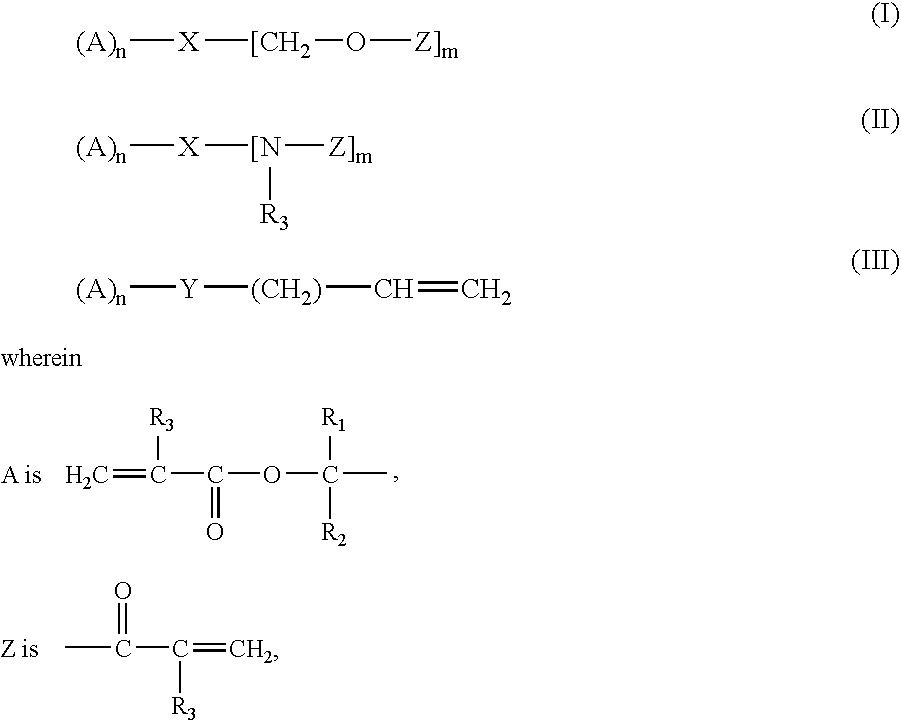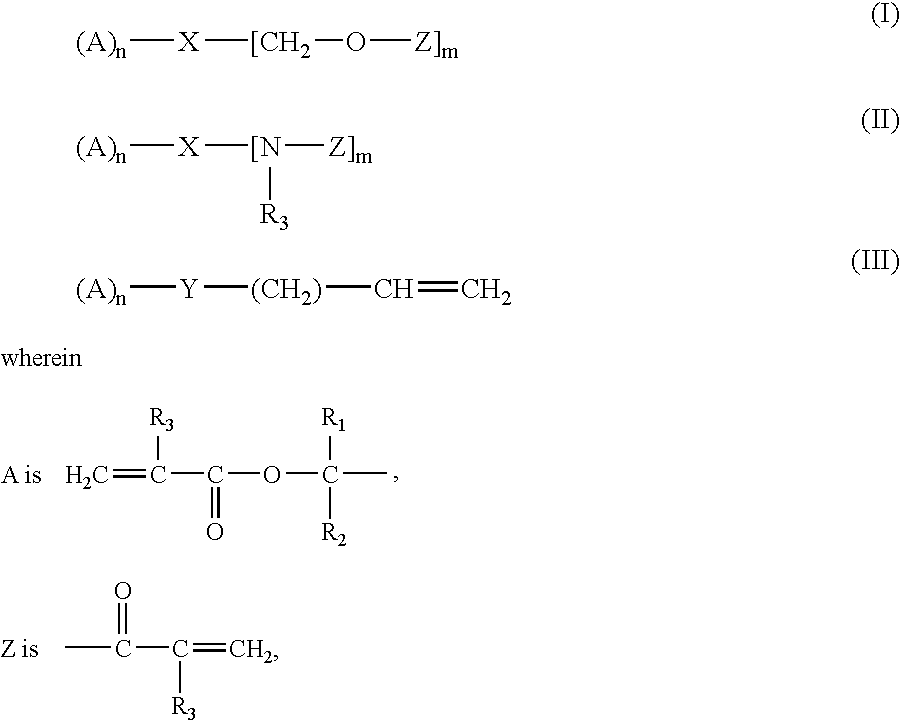Crosslinker for Superabsorbent Polymers
a superabsorbent polymer and crosslinker technology, applied in the field of compound, can solve the problems of difficult processing, undesirable degree of polymer decomposition, and the manufacture of superabsorbent polymers is faced with a dilemma, and achieves the effect of reducing crosslink density and high absorption capacity
- Summary
- Abstract
- Description
- Claims
- Application Information
AI Technical Summary
Benefits of technology
Problems solved by technology
Method used
Image
Examples
example 1
[0058]A 1 L jacketed, bottom drain, reactor is equipped with a nitrogen inlet, thermowell, pitched blade turbine type agitator and addition funnel. The apparatus is purged with nitrogen overnight prior to use. The reactor is charged with 200 ml of toluene and 28.3 g (0.27 mole) of 3-methyl-1,3-butanediol. With stirring, 84.3 g (0.83 mole) of triethylamine are added forming a clear, colorless solution with no increase in temperature. The solution is heated to 35° C. A solution of 109.4 g (1.21 mole) of 96% acryloyl chloride in 100 ml of toluene is added dropwise. A precipitate immediately forms and the reaction temperature increases. The reaction temperature is maintained between 45° C. and 50° C. by jacket cooling. Upon completion of the addition, the mixture is heated at 48° C. for 3 hours.
[0059]The mixture is cooled to 35° C. and 500 ml of deionized water are added. The mixture is stirred at 35° C. for 45 minutes in order to dissolve the precipitate. The phases are allowed to sett...
example 2
[0060]A 500 ml 3-neck round bottom flask is equipped with a nitrogen inlet, magnetic stir bar, additional funnel, temperature probe and stoppers. The flask is charged with 150 ml of toluene and 28.3 ml (0.30 mole) of 97% acryloyl chloride. Via a syringe, 10.6 ml (0.10 mole) of 3-methyl-1,3-butandediol is added. The resulting solution is warmed to 40° C. A solution of 30.6 ml (0.22 mole) of triethylamine in 100 ml of toluene is added at a slow dropwise rate with vigorous stirring. The reaction is exothermic, with a temperature rise to 50° C. The reaction temperature is maintained at approximately 50° C. by cooling with a water bath. During the addition, a flocculent precipitate forms. Upon completion of the addition, the slurry is held at approximately 50° C. via a water bath for 2 hours. After cooling to ambient temperature, the precipitate is removed by filtration. The volatiles are removed from the filtrate under vacuum leaving a pale yellow, somewhat cloudy liquid. This product i...
example 3
[0061]The crosslinker prepared in Example 2 is employed in a polymerization of partially neutralized acrylic acid as follows.
[0062]Samples are prepared in a reactor with a 2 L glass resin kettle bottom, a stainless steel agitator assembly, and a high-torque stirring motor with gear reducers. The kettle bottom has a glass jacket to allow for heating or cooling of the contents using a separate water-circulating temperature bath. The reactor can be sealed with an O-ring that fits into grooves in the kettle bottom and the steel agitator top. The monomer mix is prepared by adding 328.49 g of acrylic acid to a beaker, followed by water (377.02 g) Versenex®80 (trademark of The Dow Chemical Company) chelating agent (0.41 g), vinyl crosslinker, and optionally non-vinyl or dimodal crosslinker. To this mixture is added, with stirring, a solution of 157.03 g of sodium carbonate in 392.57 g of water. The monomer mix is loaded to the reactor under vacuum via a loading tube and the mixture is spar...
PUM
| Property | Measurement | Unit |
|---|---|---|
| temperature | aaaaa | aaaaa |
| mass | aaaaa | aaaaa |
| crosslinker composition | aaaaa | aaaaa |
Abstract
Description
Claims
Application Information
 Login to View More
Login to View More - R&D
- Intellectual Property
- Life Sciences
- Materials
- Tech Scout
- Unparalleled Data Quality
- Higher Quality Content
- 60% Fewer Hallucinations
Browse by: Latest US Patents, China's latest patents, Technical Efficacy Thesaurus, Application Domain, Technology Topic, Popular Technical Reports.
© 2025 PatSnap. All rights reserved.Legal|Privacy policy|Modern Slavery Act Transparency Statement|Sitemap|About US| Contact US: help@patsnap.com



